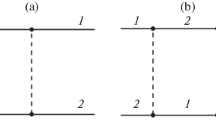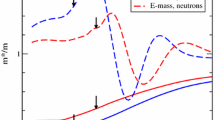Abstract
We use the Isospin-dependent Quantum Molecular Dynamics approach to analyze the influence of the neutron skin on hadronic observables in heavy-ion collisions at 400 AMeV incident energy. While the most observables on the behavior of nucleons seem to be only slightly affected, the isospin ratios of pions show a quite significant effect. It is found that the comparison of the centrality dependence at different energies allows to gain information on the neutron skin of the nuclei on one hand, but also on other ingredients like the nuclear equation of state of asymmetric matter.
Access this chapter
Tax calculation will be finalised at checkout
Purchases are for personal use only
Similar content being viewed by others
References
C. Hartnack et al., Quantum molecular dynamics: a microscopic model from Unilac to Cern energies. Nucl. Phys. A 495, 303–319 (1989)
C. Hartnack, A. Le Fèvre, Y. Leifels, J. Aichelin, CERN Proc. 1, 211 (2019)
H. Stöcker, W. Greiner, High energy heavy-ion collisions- probing the equation of state of highly excited hadronic matter. Phys. Rep. 137, 277 (1986)
W. Cassing, V. Metag, U. Mosel, K. Niita, Production of energetic particles in heavy-ion collisions. Phys. Rep. 188, 361 (1990)
J. Aichelin, Quantum molecular dynamics-a dynamical microscopic n-body approach to investigate fragment formation and the nuclear equation of state in heavy ion collisions. Phys. Rep. 202, 233–360 (1991)
A. Le Fèvre, Y. Leifels, W. Reisdorf, J. Aichelin, C. Hartnack, Constraining the nuclear matter equation of state around twice saturation density. Nucl. Phys. A 945, 112–133 (2016)
C. Hartnack, R.K. Puri, J. Aichelin, J. Konopka, S.A. Bass, H. Stoecker, W. Greiner, Modelling the many-body dynamics of heavy ion collisions: present status and future perspective. Eur. Phys. J. A 1, 151–169 (1998)
S.A. Bass, C. Hartnack, H. Stoecker, W. Greiner, Azimuthal correlations of pions in relativistic heavy ion collisions at 1-GeV/nucleon. Phys. Rev. C 51, 3343–3356 (1995)
W. Reisdorf et al., [FOPI Collaboration], Systematics of pion emission in heavy ion collisions in the 1A- GeV regime. Nucl. Phys. A 781, 459–508 (2007)
C. Hartnack, H. Oeschler, Y. Leifels, E.L. Bratkovskaya, J. Aichelin, Strangeness production close to threshold in proton-nucleus and heavy-ion collisions. Phys. Rep. 510, 119–200 (2012)
G.F. Wei, B.A. Li, J. Xu, L.W. Chen, Influence of neutron-skin thickness on \(\pi ^{-}/\pi ^{+}\) ratio in Pb+Pb collisions. Phys. Rev. C 90, 014610 (2014)
Z. Xiao, B.A. Li, L.W. Chen, G.C. Yong, M. Zhang, Circumstantial Evidence for a Soft Nuclear Symmetry Energy at Suprasaturation Densities. Phys. Rev. Lett. 102, 062502 (2009)
Z.Q. Feng, G.M. Jin, Probing high-density behavior of symmetry energy from pion emission in heavy-ion collisions. Phys. Lett. B 683, 140–144 (2010)
J. Hong, P. Danielewicz, Subthreshold pion production within a transport description of central Au + Au collisions. Phys. Rev. C 90, 024605 (2014)
M.D. Cozma, The impact of energy conservation in transport models on the \(\pi ^-/\pi ^+\) multiplicity ratio in heavy-ion collisions and the symmetry energy. Phys. Lett. B 753, 166–172 (2016)
C. Hartnack, A. Le Fèvre, Y. Leifels, J. Aichelin, The influence of neutron skin and asymmetry energy on \(\pi ^{-}/\pi ^{+}\) ratio (2018), arxiv:1808.09868
C. Hartnack, H. Oeschler, J. Aichelin, Hadronic matter is soft. Phys. Rev. Lett. 96, 012302 (2006). [arXiv:nucl-th/0506087]
Author information
Authors and Affiliations
Corresponding author
Editor information
Editors and Affiliations
Rights and permissions
Copyright information
© 2021 Springer Nature Singapore Pte Ltd.
About this paper
Cite this paper
Hartnack, C., Le Févre, A., Leifels, Y., Aichelin, J. (2021). Influence of the Neutron Skin of Nuclei on Observables. In: Puri, R.K., Aichelin, J., Gautam, S., Kumar, R. (eds) Advances in Nuclear Physics. Springer Proceedings in Physics, vol 257. Springer, Singapore. https://doi.org/10.1007/978-981-15-9062-7_11
Download citation
DOI: https://doi.org/10.1007/978-981-15-9062-7_11
Published:
Publisher Name: Springer, Singapore
Print ISBN: 978-981-15-9061-0
Online ISBN: 978-981-15-9062-7
eBook Packages: Physics and AstronomyPhysics and Astronomy (R0)




